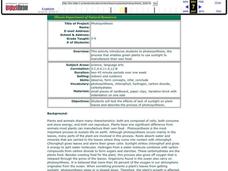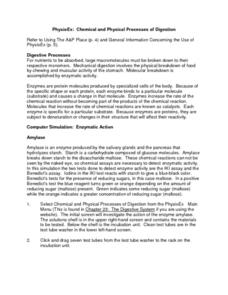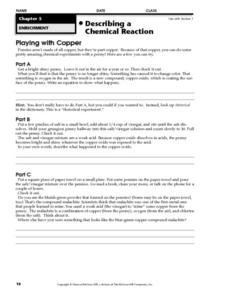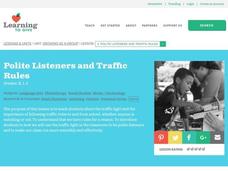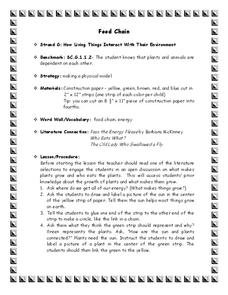Curated OER
Center for Northwestern Art: Featured Objects
Each of the slides in this presentation provide learners with an image found at a northwestern art museum and a critical analysis of what can be seen in each piece. Learners can view this prior to a museum trip in order to build...
Curated OER
Photosynthesis
Students are introduced to the process of photosynthesis. In groups, they test the effects of the lack of sunlight on plant leaves and compare the results with their hypothesis. They note the characteristics that plants and animals share...
Curated OER
PhysioEx: Chemical and Physical Processes of Digestion
In this anatomy worksheet, young scholars complete 22 review questions in the format of short answer, table completion, and fill in the blank after finishing an online virtual experiment about the chemical and physical processes of...
Curated OER
Describing a Chemical Reaction: Playing with Copper
Three experiments involving pennies help young chemists see the chemical reactions between copper and other elements. The first experiment is rhetorical (it prompts students to leave a bright penny out for a year) but the second two...
Curated OER
PKU Yes Food Target
In this PHE worksheet, students estimate and write the total amount of PHE in different foods and see if it fits into their pattern. Students do this for 28 foods.
Curated OER
Global Greenup
Students utilize satellite images to track the life cycle of vegetational growth over a large area. Animal migratory patterns are compared to this cycle.
Curated OER
Polite Listeners and Traffic Rules
Students consider the necessity of rules. In this citizenship lesson, students consider the reasons for rules and they complete traffic light activities.
Curated OER
2005 USDA Food Guide
In this food pyramid worksheet, 4th graders will answer 6 multiple choice questions about the newest version of the food pyramid (released in 2005), compare and contrast the old and new food guide using a Venn diagram, write a brief...
Curated OER
Museums in the Classroom Pumpkin Project
Students identify the 5 stages in the life cycle of a pumpkin. They create a model showing the correct order of pumpkin life stages. They explain a pumpkin's life cycle to a partner, using their model.
Curated OER
Air Pollution:What's the Solution?-Weather's Role
In this air pollution and weather worksheet, students collect data using an online animation to determine the air quality at given times along with the wind speed and temperature in a particular city. Students make 3 bar graphs using the...
Curated OER
The Stroop Effect
Students explore the specific areas of the brain that process different types of information. They examine processing conflicts. Students participate in a hands-on minds-on activity using the Stroop Effect. They design psychological...
Curated OER
Genetics Basics
In this basics of genetics worksheet, students review the concepts of genetic inheritance by writing the alleles for genetic traits inherited in offspring. They identify dominant and recessive traits given allele pairs, answer five...
Curated OER
Food Chain
Learners discuss what makes plants grow and who eats the plants. They are asked where do we get all of our energy? Students are asked to draw and label a picture of the sun in the center of the yellow strip of paper. They are explained...
Curated OER
Invertebrates
In this science worksheet, students answer the problems that are related to the concept of invertebrates. The first question has the ordering of and sorting of invertebrates.
Curated OER
The Math of Science: Ratios and Proportions
For this ratio and proportion worksheet, students learn about ratios and how to solve problems with ratios and proportions. They solve three problems using what they learned.
Curated OER
Correcting Bad Data Using Parity Bits
In this parity bits instructional activity, students read about pixels and data strings. Students are given 2 data strings that are corrupted by cosmic ray glitches and they identify the bad data and create a valid data string.
Curated OER
Transportation Unit
Students maintain a journal and write about various types of transportation. In this transportation lesson, students write using flash cards to describe vehicles. Students listen to stories and sing a song...
Curated OER
Fireworks
In this fireworks worksheet, students read about pyrotechnics and the chemical make-up of fireworks. They are given a chart of elements and the colors they emit. Students answer three critical thinking questions about fireworks and their...
Curated OER
Getting in Shape Again
Learners create rocket shapes out of pattern blocks. They draw a picture of a rocket, build a pattern block rocket following simple directions, and complete a graph of the shapes used.
Curated OER
Adding Tenths
Third graders pictorially represent tenths place with decimal bars and add decimals in the tenths place; students use decimal bars to represent tenths and solve simple addition problems with the tenths place.
Curated OER
The Wheat Plant
Students sequence stages in the life of a wheat plant. They identify the six main parts of the wheat plant. They plant some kernels of wheat in the classroom so students can watch the growth and development. They record the plant's...
Curated OER
Science Experiment: Take a Rainbow's Temperature
In this science experiment worksheet, students gather materials and perform an investigation using thermometers and prisms. Students are asked if red is hotter than blue. They answer 6 questions.
Curated OER
Life Means Water Environment
Students investigate pH levels in bodies of water and experiment with acid/base reactions. In this water and pH activity, students observe changes in pH levels of a sample solution and observe a Bronsted-Lowry reaction. Students...
Curated OER
Leaf Chromatography
In this leaf chromatography worksheet, young scholars separate the pigments of a leaf using paper chromatography. They answer 4 questions about their results and draw the colors they observe on their chromatogram from the leaf.



